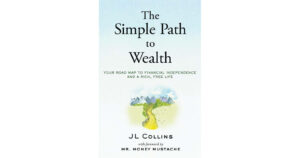Dr William J. Bernstein is a neurologist, author and financial theorist. He has several books to his credit. Among them is If You Can: How Millennials Can Get Rich Slowly, written in 2014. It is available as a pdf document, freely downloadable here. If you’d rather hold a book and turn its pages, it’s right here on Amazon.
It is a quick, easy read. But if you want the the 5-minute version, read on below:
Simple is Effective
Dr Bernstein is not the first to say this. It is deceptively simple to succeed in your investing career.
- Save 15% of your income every year, starting at age 25 [Ed: this advice will be a little different for doctors. We do not start earning until much later. Hence, we need to save more than 15%. White Coat Investor recommends 20%; Physician on FIRE challenges you to save 50% of your take-home pay. I like to go by a specific goal and working my way backwards from there. The percentage obviously depends on your income- but is not likely to be lower than 20-25%].
- Divide your savings into three equal investments: 1/3 in U.S. Total Stock Market Index Fund, 1/3 in Total International Stock Market Index Fund and 1/3 in U.S. Total Bond Market Index Fund.
- Once a year, rebalance your holdings to keep the equal thirds ratio.
This is it. All you need to get to a comfortable retirement.
The author warns that most of us in this generation will not have the luxury of a pension from our employers, therefore leaving it totally up to us to fend for ourselves when it comes to retirement savings.
“Simple is harder than complex”: Steve Jobs
Diet, exercise, patience… all simple, not easy. Following the simple path to financial freedom outlined above trips up more people than would be apparent at first glance. What are some of the reasons?
(1) Overspending
No matter how big your income, you can always outspend it. JL Collins, in Simple Path to Wealth, gives the example of Mike Tyson going bankrupt despite making $400 Million over his career.
Most of us regular folks can wipe out all good intentioned planning far more easily, unless we keep an eye out on our spending. Of course, the smaller your income, the quicker it is to get derailed.
The authors recommends the following waterfall strategy:
- Eliminate debt before beginning to save for retirement- this is a general guideline and depends on your specific situation and the interest rate on your debt versus the return you expect from your investments.
- Always put in enough into your work retirement plans to get the employer match. The return on this money is 50-100% (depending on the match), which is higher than almost all debt.
- In terms of knocking out debt, start with the one with the highest interest rate: credit card debt. Next is the car loan. And then comes student debt. Back when this book was written in 2014, student loan rates were usually higher than 5%, making it sensible to pay off before saving for retirement. With the current low-interest environment, there are people who choose to save and invest while slowly paying down their low interest student loans.
- The author quotes a nominal return of 5% for retirement savings and a real return of 3%, going forward. I will admit I use higher numbers, but not by much, 7% nominal and 4% real, to arrive at my own savings goals.
At the end of this section, Dr Bernstein has a book recommendation- my personal favorite: Stanley and Danko’s The Millionaire Next Door. This is a mindset book- one that (hopefully) cements the awareness that you have only the money that you don’t spend.
(2) Lack of Financial Awareness
You can’t quite succeed in taking care of your finances if you don’t know the first thing about investing. Dr Bernstein says, and I wholeheartedly agree, it’s not hard- nowhere near med school-hard. It is frontloaded, though- you have to know some basic principles and some jargon- and then you’re good to go.
- The author explains the difference between stocks and bonds. Bonds are lower risk and therefore lower return. Stocks have enormous upside but also enormous risk- and hence need higher returns to entice investors.
- He also warns that most investors are likely to overestimate their risk tolerance. You may know, in theory, that a market crash will eventually correct. However, it is an entirely different thing to see your savings or net worth be cut in half and not react rashly.
- So, should you try to time the market. Nope. It doesn’t work. “Even a broken clock is right twice a day”, the author reminds us. This, to say that any stock picking, by an active manager or an investor, is a matter of luck rather than skill.
For this section, the author’s book pick is Jack Bogle’s Common Sense on Mutual Funds. Bogle, as you all know, was the founder of Vanguard. Vanguard is the only mutual fund company in the world to give its investors ownership of the company. So, it serves only one master. And is therefore able to run at rock-bottom prices.
(3) Not knowing Financial and Market History
Outside of the basics of investing, knowing the history of market behaviors is essential. It helps, when the market is violently whiplashing, to know and remember that this has happened before. And hence, this too shall pass.
- The author gives us a timely reminder for these times, that when the health of the economy is shaky, that’s when the market performs best. This again goes back to the inverse relationship between risk and return. When it looks like the apocalypse is near, everyone flees the market. That is, in fact, the perfect time to go all in.
- On the other hand, when all everyone is talking about is their investments, it is a sign of market euphoria- and the party may not last long.
- Knowing market history is not meant to suggest that you can time the market. It “only” serves to emotionally stabilize you when it appears that all is lost and will never recover.
- In that respect, rebalancing your assets once a year forces you to do the opposite of market-time. You either sell your high-performing assets or buy more of the low-performing ones, to stay at your desired allocation.
The reading assignment for this section is two books- Edward Chancellor’s Devil Take the Hindmost and The Great Depression: A Diary by Benjamin Roth. These two books are lessons, both of market exuberance and the deepest depths.
(4) Know Thyself
Evolutionarily, we’re wired to assess and react to short-term risk. Which is what selling off during a market downturn is. In finance, the real risks are long term: the discipline to keep saving and investing and to hold it together during the rollercoaster ride that market volatility is.
- Most people think they’re better than average- at many things, including investing- which is statistically impossible. And not to incite controversy, but apparently men are worse at this than women. And hence make worse investors.
- People have something called “recency bias”. When something has just happened, we think it will go on forever. Like when the market is doing well, we think it will keep doing well. This brings in more people into the fold and keeps it moving upwards, until it doesn’t.
- Humans seek patterns in all things. It gives us meaning in this chaotic world. Unfortunately, the market is all noise, no pattern. Looking for one gets you to fall into the market-timing trap.
Dr Bernsteins’s book recommendation for this section is Your Money and Your Brain by Wall Street Journal personal finance columnist, Jason Zweig.
(5) “Monsters” in the finance industry
In the author’s own words. It has been said before that the finance industry professionals are out to separate you from your money. If you choose to work with one, you have to vet them very very carefully. And for that, you have to know enough about this stuff to judge whether you’re getting fleeced.
- Treat any involvement with the finance industry as an “urban combat zone”. Do not let your guard down.
- This industry is rife with unscrupulous and incompetent folks. There is no uniformity in education that is needed to call oneself a “financial advisor”.
- Fiduciary duty to clients is only optional, not mandatory.
- Mutual fund companies have the same conflicts of interest, though to a lesser extent, due to regulatory oversight. The expenses of a fund turn out to be more than just the expense ratio of the fund. For actively managed funds, it is overshadowed by management fees and transactional costs of moving shares in and out of the fund- all of which comes out of the fund’s returns.
Dr Bernstein is not mincing words when he closes this section with “you are engaged in a life and death struggle with the financial services industry. Every dollar in fees and expenses that you pay them come out of your pocket”. [Ed: this is a big reason I write this blog. I want to connect my friends and peers with the good folks in finance. The recommended resources page is coming soon. Stay tuned!].

Implementing the roadmap
- Eliminate high-interest debt.
- Put in enough into your work retirement plans to get your employer match- put everything else towards debt.
- Fund an emergency fund to cover six months of expenses. Put it in cash equivalents, such as Treasury-bills, CDs and money market funds. And not in a retirement account- where it is hard to get them out.
- Once the debt is wiped out, start saving in earnest towards retirement. Max out your tax-advantaged retirement accounts.
- Apart from employer-related accounts, there are Individual Retirement Accounts (IRAs). they come in two flavors: Traditional and Roth.
- Traditional IRAs are pre-tax below a certain Modified Adjusted Gross Income. Above it, it is non-deductible.
- Below this MAGI threshold, you can contribute directly to a Roth IRA with post-tax money. Above it, it makes sense to convert your non-deductible IRA to a Backdoor Roth IRA.
- The 15% savings rate recommended by the author is the minimum you must save. In reality, it is better to save as much as you can.
- This usually means that apart from your work retirement plan and IRA/Roth IRA, you also stash money into a taxable brokerage account.
- Look carefully at the funds in your 401(k). The author recommends that if the Expense ratios are greater than 1%, to put in only enough into your 401(k) as to get the employer match. [Ed: The math doesn’t work the same way for high-income earners. As a physician, your tax benefit from contributing to your 401(k) almost always more than makes up for the terrible investments in it].
- Consider all your retirement accounts as one when you consider asset allocation.
- Many 401(k)’s have Target Date Funds in their investment lineup. This is often a good, low-hassle and fairly low-cost option if the three fund portfolio appears too complex for you.
- On the other hand, there is nothing wrong with complicating a portfolio further with REITs. Emerging markets, etc if you are so inclined. [Ed: The challenge often is to stick to your asset allocation through years of low performance. So, pick your allocation wisely].
The author ends with two more superb book recommendations: How A Second Grader Beats Wall Street by Alan Roth and All About Asset Allocation by Rick Ferri.
And that’s it. A short, easy read full of pearls.
Thank you for reading. I would appreciate your questions or comments below! Please note, this post has affiliate links- which means I earn a small commission if you go through these links, without any cost to you.





